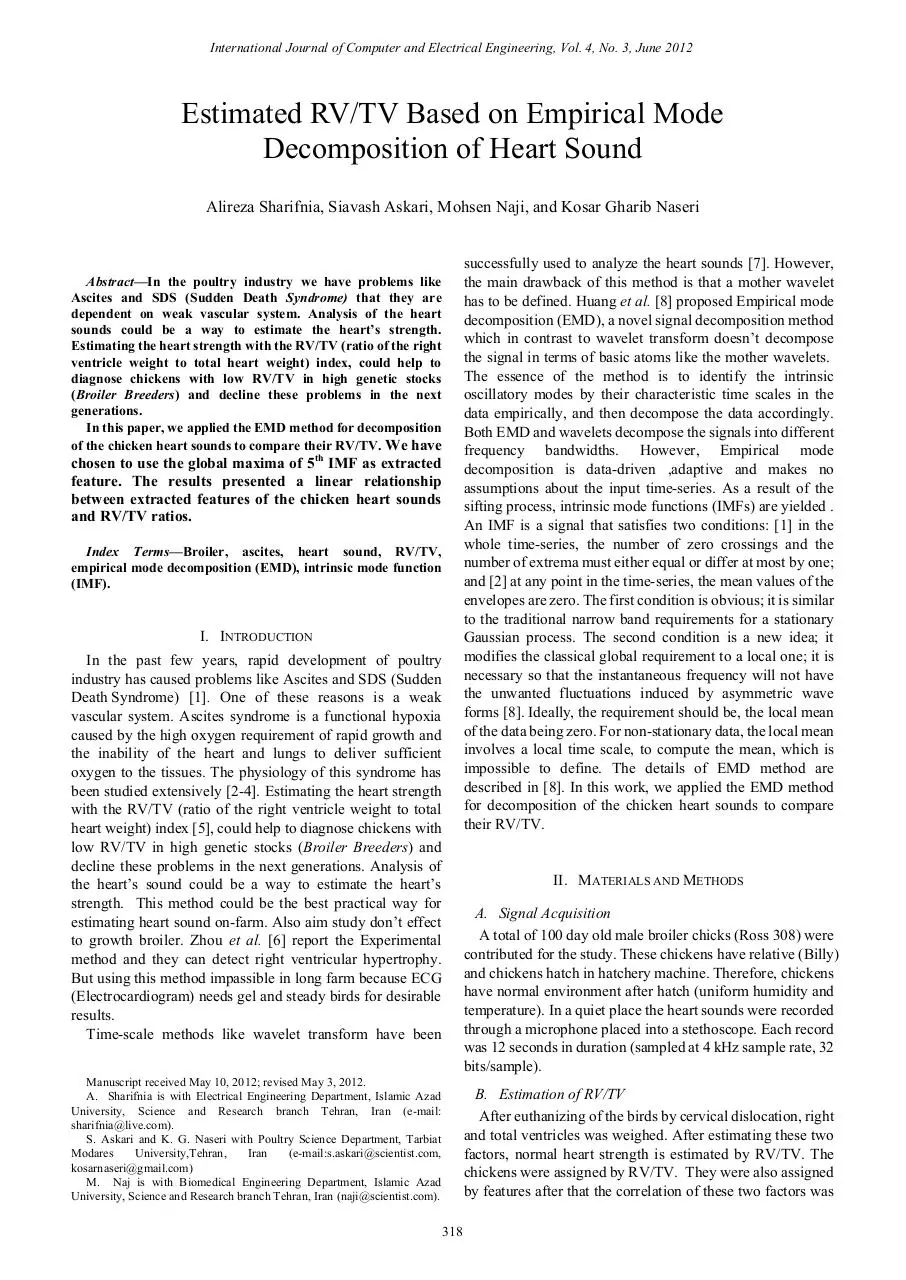Heart sound (PDF)
File information
This PDF 1.4 document has been generated by Nitro Pro 7 (7. 4. 1. 8), and has been sent on pdf-archive.com on 28/09/2015 at 14:40, from IP address 188.245.x.x.
The current document download page has been viewed 421 times.
File size: 137.84 KB (1 page).
Privacy: public file

File preview
International Journal of Computer and Electrical Engineering, Vol. 4, No. 3, June 2012
Estimated RV/TV Based on Empirical Mode
Decomposition of Heart Sound
Alireza Sharifnia, Siavash Askari, Mohsen Naji, and Kosar Gharib Naseri
successfully used to analyze the heart sounds [7]. However,
the main drawback of this method is that a mother wavelet
has to be defined. Huang et al. [8] proposed Empirical mode
decomposition (EMD), a novel signal decomposition method
which in contrast to wavelet transform doesnt decompose
the signal in terms of basic atoms like the mother wavelets.
The essence of the method is to identify the intrinsic
oscillatory modes by their characteristic time scales in the
data empirically, and then decompose the data accordingly.
Both EMD and wavelets decompose the signals into different
frequency bandwidths. However, Empirical mode
decomposition is data-driven ,adaptive and makes no
assumptions about the input time-series. As a result of the
sifting process, intrinsic mode functions (IMFs) are yielded .
An IMF is a signal that satisfies two conditions: [1] in the
whole time-series, the number of zero crossings and the
number of extrema must either equal or differ at most by one;
and [2] at any point in the time-series, the mean values of the
envelopes are zero. The first condition is obvious; it is similar
to the traditional narrow band requirements for a stationary
Gaussian process. The second condition is a new idea; it
modifies the classical global requirement to a local one; it is
necessary so that the instantaneous frequency will not have
the unwanted fluctuations induced by asymmetric wave
forms [8]. Ideally, the requirement should be, the local mean
of the data being zero. For non-stationary data, the local mean
involves a local time scale, to compute the mean, which is
impossible to define. The details of EMD method are
described in [8]. In this work, we applied the EMD method
for decomposition of the chicken heart sounds to compare
their RV/TV.
AbstractIn the poultry industry we have problems like
Ascites and SDS (Sudden Death Syndrome) that they are
dependent on weak vascular system. Analysis of the heart
sounds could be a way to estimate the hearts strength.
Estimating the heart strength with the RV/TV (ratio of the right
ventricle weight to total heart weight) index, could help to
diagnose chickens with low RV/TV in high genetic stocks
(Broiler Breeders) and decline these problems in the next
generations.
In this paper, we applied the EMD method for decomposition
of the chicken heart sounds to compare their RV/TV. We have
chosen to use the global maxima of 5th IMF as extracted
feature. The results presented a linear relationship
between extracted features of the chicken heart sounds
and RV/TV ratios.
Index TermsBroiler, ascites, heart sound, RV/TV,
empirical mode decomposition (EMD), intrinsic mode function
(IMF).
I. INTRODUCTION
In the past few years, rapid development of poultry
industry has caused problems like Ascites and SDS (Sudden
Death Syndrome) [1]. One of these reasons is a weak
vascular system. Ascites syndrome is a functional hypoxia
caused by the high oxygen requirement of rapid growth and
the inability of the heart and lungs to deliver sufficient
oxygen to the tissues. The physiology of this syndrome has
been studied extensively [2-4]. Estimating the heart strength
with the RV/TV (ratio of the right ventricle weight to total
heart weight) index [5], could help to diagnose chickens with
low RV/TV in high genetic stocks (Broiler Breeders) and
decline these problems in the next generations. Analysis of
the hearts sound could be a way to estimate the hearts
strength. This method could be the best practical way for
estimating heart sound on-farm. Also aim study dont effect
to growth broiler. Zhou et al. [6] report the Experimental
method and they can detect right ventricular hypertrophy.
But using this method impassible in long farm because ECG
(Electrocardiogram) needs gel and steady birds for desirable
results.
Time-scale methods like wavelet transform have been
II. MATERIALS AND METHODS
A. Signal Acquisition
A total of 100 day old male broiler chicks (Ross 308) were
contributed for the study. These chickens have relative (Billy)
and chickens hatch in hatchery machine. Therefore, chickens
have normal environment after hatch (uniform humidity and
temperature). In a quiet place the heart sounds were recorded
through a microphone placed into a stethoscope. Each record
was 12 seconds in duration (sampled at 4 kHz sample rate, 32
bits/sample).
Manuscript received May 10, 2012; revised May 3, 2012.
A. Sharifnia is with Electrical Engineering Department, Islamic Azad
University, Science and Research branch Tehran, Iran (e-mail:
sharifnia@live.com).
S. Askari and K. G. Naseri with Poultry Science Department, Tarbiat
Modares
University,Tehran,
Iran
(e-mail:s.askari@scientist.com,
kosarnaseri@gmail.com)
M. Naj is with Biomedical Engineering Department, Islamic Azad
University, Science and Research branch Tehran, Iran (naji@scientist.com).
B. Estimation of RV/TV
After euthanizing of the birds by cervical dislocation, right
and total ventricles was weighed. After estimating these two
factors, normal heart strength is estimated by RV/TV. The
chickens were assigned by RV/TV. They were also assigned
by features after that the correlation of these two factors was
318
Download Heart sound
Heart sound.pdf (PDF, 137.84 KB)
Download PDF
Share this file on social networks
Link to this page
Permanent link
Use the permanent link to the download page to share your document on Facebook, Twitter, LinkedIn, or directly with a contact by e-Mail, Messenger, Whatsapp, Line..
Short link
Use the short link to share your document on Twitter or by text message (SMS)
HTML Code
Copy the following HTML code to share your document on a Website or Blog
QR Code to this page

This file has been shared publicly by a user of PDF Archive.
Document ID: 0000303838.